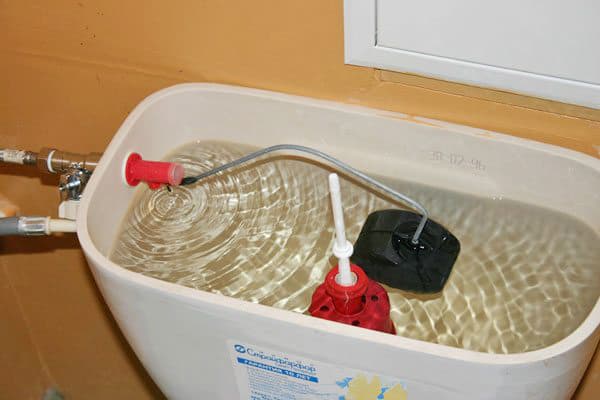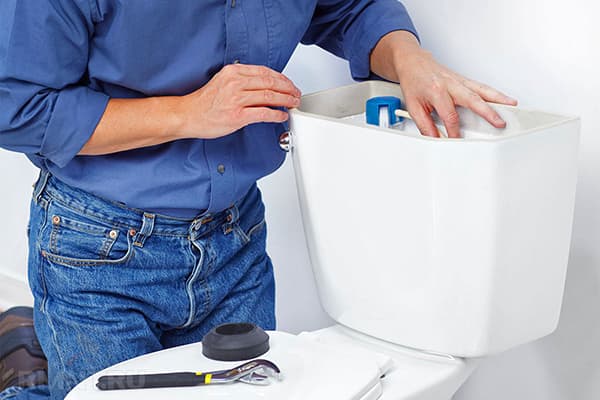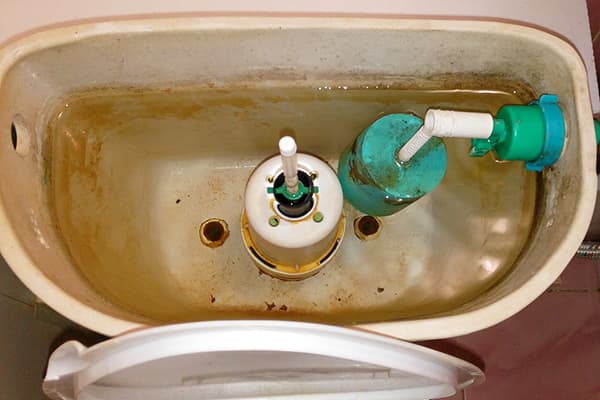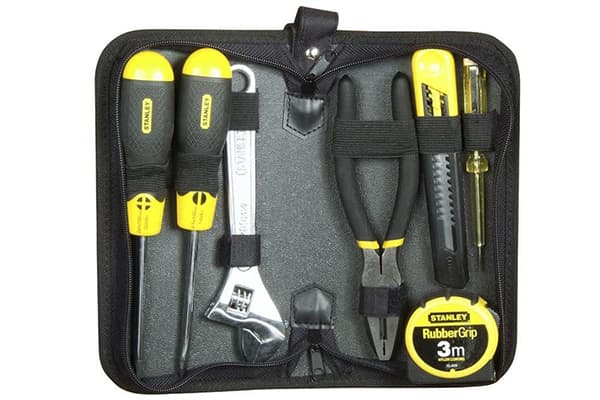Water constantly flows in the toilet - we repair the tank ourselves
Content:
Among the plumbing malfunctions, the condition when water constantly flows in the toilet is one of the most insidious. This breakdown is easily overlooked, and the wasting liters will gradually accumulate until the amount in the monthly payment slip goes beyond all reasonable limits. To avoid financial losses and further problems with plumbing, urgent need to take action.
How to determine that a leak has appeared?
During normal operation of the toilet bowl, after pressing the drain valve button, the contents of the tank are discharged into the toilet bowl, taking waste products to the sewer. After the tank is empty, the float of the valve regulating the water supply is lowered. Tap cold water begins to fill the tank. After filling, the float again pops up, and the valve shuts off the fluid supply.
If the drain fittings or the plumbing device itself are faulty, water begins to flow into the bowl non-stop, and not only after pressing the drain button. In this case, water enters the storage tank constantly (and immediately pours out of it again). In fact, leakage in the toilet is the same hole in the family budget as a leaking tap. Therefore, the sooner you can detect the problem, the better.
To notice a leak, you need to know the signs of its appearance:
- The sound of incoming water is constantly heard from the tank.
- The surface on which the water flows continuously remains wet.
- Leaks of rust quickly occur at the exit point of the water stream.
- The impeller of the meter continues to move with closed taps and non-working plumbing fixtures.
Caution should be exercised if drops of water condensation appear on the hose through which water enters the tank. These droplets occur on cold surfaces. The water supply hose will be constantly cold if water flows continuously. With periodic supply, it will have time to warm up to room temperature.
If you find at least one sign of a leak, check the others as soon as possible. If you see at least 2–3 signs from the list, turn off the water supply to the accumulative capacity of the toilet bowl and take measures to eliminate the malfunction.
Ways to solve the problem
Having stopped the supply of water to the tank, it is possible to buy time to fix it. But we must act quickly: it’s very inconvenient to live in the toilet without water. Of course, you can invite plumbing from the UK or a private company. But many types of repairs are easy to carry out yourself.
Acting ineptly, you can significantly damage the toilet or drain fittings. After that, you will need to invest a lot more money in the repair or completely change the toilet.
Before repair, look at the scheme of the device for drain valves from your toilet. This instruction is included with the toilet when purchased. The scheme can also be found on the Internet.
Why is the tank leaking?
So, the decision was made to cope with the repair on their own. The first step is to find the cause of the leak.
There may be several reasons for the leak:
- Damage to the valve blocking the water supply. In this case, the liquid rises above the neck of the overflow pipe and goes into the bowl.
- Dirty water. If solid particles (rust, particles of sand, etc.) are trapped in the fluid entering the drainage system, they may fall under the rubber of the drain valve.
- Wear or deformation of the rubber band. Because of this, the exit from the storage tank does not completely overlap, and the water finds its way into the bowl.
- Damage to drain valves. Cracks or holes in plastic parts are a common cause of leaks.
- Crack in sanitary ceramics. The most unpleasant option that may require replacing the entire toilet.
Having identified the problem, it should be fixed.
What is needed for repair?
For repair, you will need the simplest tools that are in every home: screwdrivers, a work knife, a hammer, a piece of sandpaper, pliers or a set of wrenches. You will also need sealing material - tow with solid oil and plumbing sealant.
It is also worth preparing a piece of rags to wipe your hands during work. If the water tap for the toilet is located in another room, it is best to work with an assistant.
How to fix a leak with your own hands?
First of all, you need to carefully remove the tank cap. Start by checking the valve blocking the fluid supply. Raise the float so that the water stops flowing. If the leak is fixed, you need to adjust the position of the float on the rod.
If this does not help, you need to remove the drain valves and inspect the condition of the sealing gum. Often enough to clean it from dirt to restore the normal operation of the mechanism.
If this does not help, you will have to disassemble the tank in the search for failed parts. These can be gaskets between the tank and the shelf, bolts, tightening parts or parts of the drain valve.
- The float may leak water due to a clogged gum. To clean it, it is necessary to disassemble the attachment point of the float lever. After disassembly, the gaskets are washed and the gum on the lever is replaced (a workout is often formed in it). To understand how this work is done, the video instruction will help:
- Another problem area is the rubber of the locking mechanism. Over time, it warps, and the valve begins to jam. The problem is that with the low cost of the gasket itself in the store, this part may be missing. It is unprofitable to buy whole reinforcement (for 800–900 rubles) for the sake of a 15-ruble gum. It is worth choosing a more or less suitable gum from the domestic assortment, cut and put it in place. We offer video instructions for this operation:
- If you decide to change the entire valve, you will have to turn off the water supply and empty the tank. Then we unscrew the water supply hose with a key (a little liquid may pour out - we substitute the container). Then we unscrew the fasteners and remove the tank. This will allow you to get to the plastic nuts holding the fittings. We turn them off, remove the shut-off valve and the float assembly, and install new parts. All stages of work are shown in the video:
Such a repair for a novice plumber is already quite complicated, it is better to seek the help of an experienced specialist. But if this is not possible, you can figure it out yourself. The main thing is to do everything slowly, periodically referring to the instructions for the fittings. Good luck in your work!




And if the tank at the end of the flow of water emits trills?
There is another reason for the leak. This is the accumulation of lime at the base of the overlapping lever. A hard lump forms and prevents it from working properly. I had such a story, the master came and quickly found the reason. I cleaned the structure, it worked.
I don’t know how I didn’t come across the Czech-made fittings, but if ours leaks from under the valve’s gum, it’s enough to disconnect the stem with gasket from the fittings and lower it with an elastic band into the bowl with boiling water, and when the rubber softens, give it its original shape. To save water when assembling fittings,put a small weight on the rod with an elastic band (I have, for example, 3/4 brass nut), then when you press the drain button, the water will not completely empty the tank, and when you release your finger, the rod instantly returns to its original position!
The very idea of a drain tank is vicious .... it was good at low water pressure .. but right now the pressure is such that I’ll wash my poop with a shower ... But there are no tank-free toilets for domestic purposes.
Any industrial garbage. But no toilets
In Moscow, any metal in the tank rots in a couple of years ... bolts and they rot. Only plastic and this good is not enough. And the gum is too hard and does not provide a tight fit .... and after the same two years, lime settles on elastic bands ... I tell you, the tank itself is bad as a device